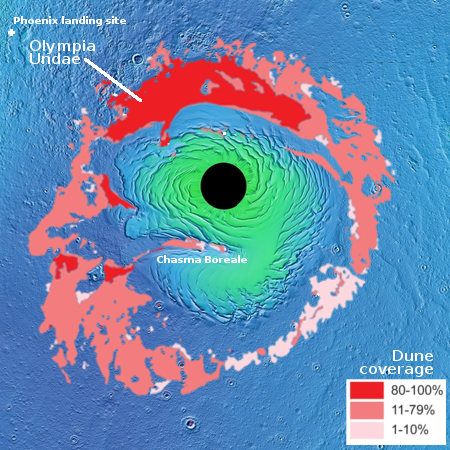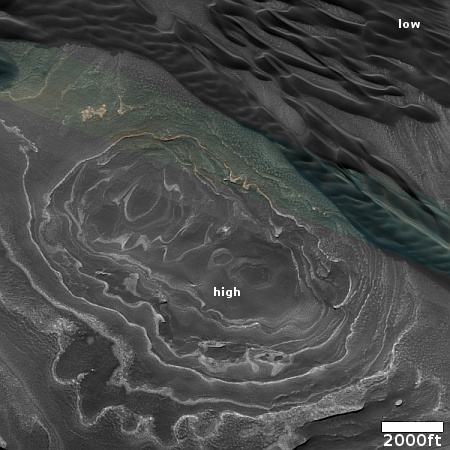Sand dunes inside the Martian north polar icecap
Today’s cool image returns to the Martian north pole. The picture to the right, rotated, cropped, reduced, and enhanced to post here, was taken on July 3, 2025 by the high resolution camera on Mars Reconnaissance Orbiter (MRO). It shows the top of a ridge near the edge of that icecap, with dunes visible in the hollow several thousand feet below.
The angle of this picture does not show us the many layers on the cliff leading down to those dunes. It does show evidence, however, of the top few layers on the flat crest of that ridge. The white lines delineate those layers, each line marking the edge of a series of wide terraces.
The dunes in the canyon below are of interest because their source is likely the dust that is mixed into thick icecap’s ice. As that ice sublimates away on the face of the cliff, the dust falls into the canyon, where it is trapped.

The white dot on the overview map to the right, located at the upper edge of the cap (indicated by green), marks this location. The canyon itself is named Olympia Cavi. If you look close at the map you will see that within that canyon orbital images have found that there are sections of the floor that are extensively covered with these dunes, from 11% to 79%.
As I noted in yesterday’s cool image, research has suggested that the vast Olympia Undae dune sea that surrounds the north pole icecap likely comes from the dust in that cap, in a process similar to what I have described above, and coming from the several prongs of that sea that poke into the icecap.
The picture was taken in the summer, so another goal is likely to monitor this location for avalanches or changes in the dunes themsleves. To do so, scientists have snapped images of this location going back to 2008.
On Christmas Eve 1968 three Americans became the first humans to visit another world. What they did to celebrate was unexpected and profound, and will be remembered throughout all human history. Genesis: the Story of Apollo 8, Robert Zimmerman's classic history of humanity's first journey to another world, tells that story, and it is now available as both an ebook and an audiobook, both with a foreword by Valerie Anders and a new introduction by Robert Zimmerman.
The print edition can be purchased at Amazon or from any other book seller. If you want an autographed copy the price is $60 for the hardback and $45 for the paperback, plus $8 shipping for each. Go here for purchasing details. The ebook is available everywhere for $5.99 (before discount) at amazon, or direct from my ebook publisher, ebookit. If you buy it from ebookit you don't support the big tech companies and the author gets a bigger cut much sooner.
The audiobook is also available at all these vendors, and is also free with a 30-day trial membership to Audible.
"Not simply about one mission, [Genesis] is also the history of America's quest for the moon... Zimmerman has done a masterful job of tying disparate events together into a solid account of one of America's greatest human triumphs."--San Antonio Express-News
Today’s cool image returns to the Martian north pole. The picture to the right, rotated, cropped, reduced, and enhanced to post here, was taken on July 3, 2025 by the high resolution camera on Mars Reconnaissance Orbiter (MRO). It shows the top of a ridge near the edge of that icecap, with dunes visible in the hollow several thousand feet below.
The angle of this picture does not show us the many layers on the cliff leading down to those dunes. It does show evidence, however, of the top few layers on the flat crest of that ridge. The white lines delineate those layers, each line marking the edge of a series of wide terraces.
The dunes in the canyon below are of interest because their source is likely the dust that is mixed into thick icecap’s ice. As that ice sublimates away on the face of the cliff, the dust falls into the canyon, where it is trapped.

The white dot on the overview map to the right, located at the upper edge of the cap (indicated by green), marks this location. The canyon itself is named Olympia Cavi. If you look close at the map you will see that within that canyon orbital images have found that there are sections of the floor that are extensively covered with these dunes, from 11% to 79%.
As I noted in yesterday’s cool image, research has suggested that the vast Olympia Undae dune sea that surrounds the north pole icecap likely comes from the dust in that cap, in a process similar to what I have described above, and coming from the several prongs of that sea that poke into the icecap.
The picture was taken in the summer, so another goal is likely to monitor this location for avalanches or changes in the dunes themsleves. To do so, scientists have snapped images of this location going back to 2008.
On Christmas Eve 1968 three Americans became the first humans to visit another world. What they did to celebrate was unexpected and profound, and will be remembered throughout all human history. Genesis: the Story of Apollo 8, Robert Zimmerman's classic history of humanity's first journey to another world, tells that story, and it is now available as both an ebook and an audiobook, both with a foreword by Valerie Anders and a new introduction by Robert Zimmerman.
The print edition can be purchased at Amazon or from any other book seller. If you want an autographed copy the price is $60 for the hardback and $45 for the paperback, plus $8 shipping for each. Go here for purchasing details. The ebook is available everywhere for $5.99 (before discount) at amazon, or direct from my ebook publisher, ebookit. If you buy it from ebookit you don't support the big tech companies and the author gets a bigger cut much sooner.
The audiobook is also available at all these vendors, and is also free with a 30-day trial membership to Audible.
"Not simply about one mission, [Genesis] is also the history of America's quest for the moon... Zimmerman has done a masterful job of tying disparate events together into a solid account of one of America's greatest human triumphs."--San Antonio Express-News



Mars impacts
https://phys.org/news/2025-08-mars-mantle-chaotic-features-colossal.html
“The inside of Mars isn’t smooth and uniform like familiar textbook illustrations. Instead, new research reveals it’s chunky—more like a Rocky Road brownie than a neat slice of Millionaire’s Shortbread.”
Mars metals
https://phys.org/news/2025-08-metals-martian-dirt.html
https://linkinghub.elsevier.com/retrieve/pii/S0094576525002814
“The simulant is placed inside a chamber at Mars surface pressure and heated at increasing temperatures. The experiments showed pure iron metal formation around 1,000°C, with liquid iron-silicon alloys produced around 1400°C.”